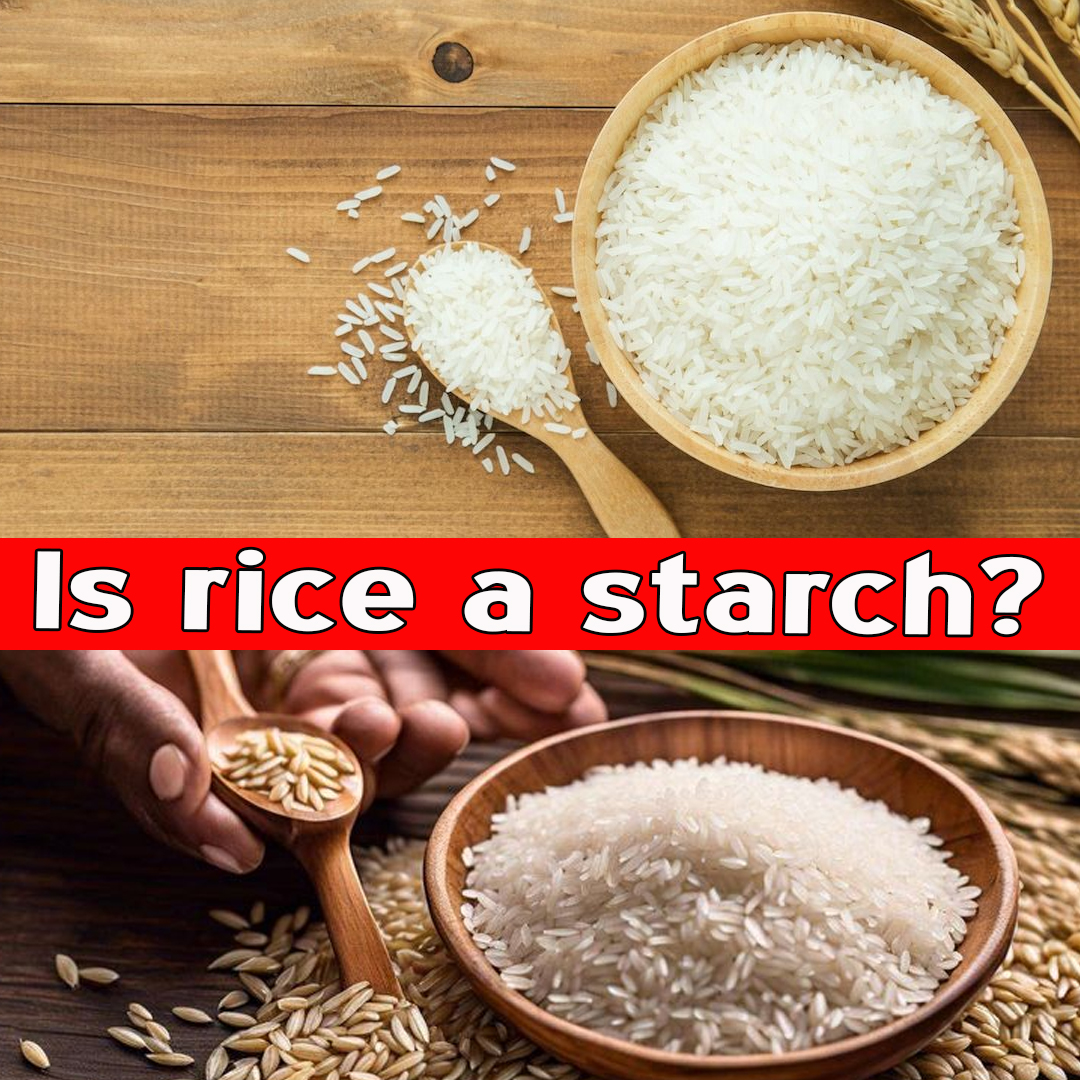Is Rice a Starch?

Is rice a starch?
Rice is one of the most widely consumed staple foods in the world, forming the dietary backbone for billions of people, particularly across Asia, Africa, and Latin America. But when people talk about “carbs” or “starches,” rice often finds itself at the center of nutritional debates. So, is rice a starch?
Table of Contents:
- Introduction to Starch
- Rice Composition
- Different Types of Starch in Rice
- Types of Rice and Starch Content
- Starch and Digestion
- Glycemic Index and Its Impact
- Is All Rice Created Equal?
- Resistant Starch and Health Benefits
- Brown vs White Rice: A Nutritional Comparison
- Rice in Popular Diets
- Health Implications of Rice Consumption
- Ways to Reduce the Negative Effects of Starch in Rice
- Conclusion
1. Introduction to Starch
Depending on how the starch behaves during digestion, it may have different impacts on blood sugar, gut health, and energy levels.
There are three main types of starch:
- Rapidly digestible starch (RDS)
- Slowly digestible starch (SDS)
- Resistant starch (RS)
These types determine how starch affects blood sugar and metabolism.
2. Rice Composition
Rice is primarily composed of carbohydrates (70–80% by weight when dry), with a minimal amount of fat and a modest amount of protein. The majority of these carbohydrates are in the form of starch, making rice a high-starch food.
Other components of rice include:
- Fiber (more in brown rice)
- Protein
- Vitamins and minerals (such as B vitamins, iron, magnesium, and phosphorus)
- Trace amounts of fat
3. Different Types of Starch in Rice
The starch in rice is made up of two types of polysaccharides:
- Amylose: A long, linear chain of glucose molecules. It is more resistant to digestion and is associated with lower glycemic index (GI).
- Amylopectin: A highly branched chain of glucose molecules. It is digested quickly and raises blood sugar more rapidly.
The ratio of amylose to amylopectin affects the texture, cooking behavior, and nutritional properties of rice:
- High-amylose rice: Firmer when cooked, digested slowly.
- High-amylopectin rice: Sticky when cooked, digested quickly.
4. Types of Rice and Starch Content
There are several varieties of rice, each with unique starch profiles:
| Type of Rice | Amylose Content | Glycemic Index | Texture |
|---|---|---|---|
| Basmati | High (20–25%) | Low (50–58) | Fluffy |
| Jasmine | Medium-Low (12–18%) | Medium-High | Soft |
| Short-grain (sushi rice) | Low (<10%) | High (72–89) | Sticky |
| Brown rice | Medium-High | Medium | Chewy |
| Parboiled rice | High | Low-Medium | Firm |
Key Takeaway: The higher the amylose content, the slower the digestion and better the impact on blood sugar.
5. Starch and Digestion
When rice is eaten, enzymes in the saliva and small intestine begin breaking down the starch into glucose. Depending on the starch structure:
- Amylopectin-rich rice is digested quickly, leading to blood sugar spikes.
- Amylose-rich rice resists digestion, moderating the glycemic response.
Some starch escapes digestion and reaches the colon, where it acts like dietary fiber. This is known as resistant starch.
| Read more – Is popcorn a grain? |
6. Glycemic Index and Its Impact
The Glycemic Index (GI) ranks carbohydrates from 0 to 100 based on how quickly they raise blood sugar. Rice’s GI varies greatly depending on the type:
- High GI (70–100): White rice, sticky rice
- Medium GI (56–69): Jasmine rice, brown rice
- Low GI (≤55): Basmati, parboiled rice
High-GI rice causes faster blood sugar spikes, which can be problematic for people with diabetes, insulin resistance, or metabolic syndrome.
7. Is All Rice Created Equal?
Absolutely not. The nutritional and metabolic impact of rice depends heavily on its variety and processing:
- White rice: Milled and polished; lower in fiber and nutrients.
- Brown rice: Whole grain with bran and germ intact; higher in fiber, minerals, and B vitamins.
- Black/purple/red rice: Rich in antioxidants; considered healthier.
- Parboiled rice: Partially boiled in the husk, making it more nutrient-retentive and lower GI.
8. Resistant Starch and Health Benefits
Resistant starch (RS) is a type of starch that resists digestion in the small intestine and ferments in the large intestine, feeding beneficial gut bacteria.
Ways to increase RS in rice:
- Cook and cool: Chilling rice after cooking increases RS content.
- Reheating cooled rice: Doesn’t reduce RS content.
Benefits of RS include:
- Improved insulin sensitivity
- Reduced appetite
- Better colon health
- Lower risk of colon cancer
9. Brown vs White Rice: A Nutritional Comparison
| Nutrient | White Rice (1 cup) | Brown Rice (1 cup) |
|---|---|---|
| Calories | ~205 | ~215 |
| Carbohydrates | 45g | 45g |
| Fiber | 0.6g | 3.5g |
| Protein | 4.3g | 5g |
| Magnesium | 19mg | 84mg |
| Iron | 1.9mg | 0.8mg |
Key Differences:
- Brown rice has more fiber, vitamins, and minerals.
- White rice is less nutritious but easier to digest.
10. Rice in Popular Diets
- Keto: Rice is usually avoided due to high carb/starch content.
- Paleo: Excludes grains, including rice.
- Low-Carb: Limits or eliminates rice.
- Vegan/Vegetarian: Rice is often a staple source of energy.
- Gluten-Free: Rice is naturally gluten-free and widely used.
11. Health Implications of Rice Consumption
Benefits:
- Affordable, energy-rich
- Easy to digest
- Gluten-free
- Versatile in cuisines
Concerns:
- High in carbohydrates/starch
- Low in fiber (white rice)
- May spike blood sugar
- Possible arsenic contamination (especially in brown rice)
Moderation is key. Choosing the right type of rice, appropriate portion sizes, and combining it with fiber/protein/fat can mitigate health concerns.
12. Ways to Reduce the Negative Effects of Starch in Rice
- Choose high-amylose varieties like basmati or parboiled rice.
- Opt for brown or wild rice for more fiber.
- Cool and reheat rice to boost resistant starch.
- Combine with legumes or vegetables to slow digestion.
- Watch portions: ½ cup cooked rice is often sufficient.
- Avoid frying or pairing with sugary sauces.
13. Conclusion
So, is rice a starch? Yes—rice is mostly composed of starch, specifically a combination of amylose and amylopectin. This starch content gives rice its energy-dense qualities but also determines how it impacts blood sugar and health.















Leave a Reply